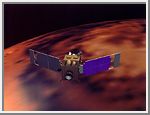|
COMETS EARTH JUPITER KUIPER BELT MARS MERCURY METEORITES NEPTUNE OORT CLOUD PLUTO SATURN SOLAR SYSTEM SPACE SUN URANUS VENUS ORDER PRINTS
PHOTO CATEGORIES SCIENCEVIEWS AMERICAN INDIAN AMPHIBIANS BIRDS BUGS FINE ART FOSSILS THE ISLANDS HISTORICAL PHOTOS MAMMALS OTHER PARKS PLANTS RELIGIOUS REPTILES SCIENCEVIEWS PRINTS
|
Related Document
Download Options
This computer-designed view of Mars Global Surveyor shows the modified aerobraking configuration which will be used to compensate for a solar panel that did not fully deploy after launch. The 3.5-meter (11-foot) wing on the right is the panel that did not latch in place after deployment. Consequently, it will be rotated 180 degrees so that the solar-cell side of the panel (the blue surface seen here) faces into the direction of the air flow that exerts drag force on the spacecraft as it dips repeatedly into the atmosphere. This way, the unlatched panel will not be in danger of folding up onto the spacecraft's main structure, nor will the panel be at any greater risk of heating up too much. Engineers on the Surveyor flight team determined that a piece of metal called the "damper arm," which is part of the solar array deployment mechanism located at the "shoulder" joint, where the entire panel is attached to the spacecraft body, was probably sheared off during deployment in the first day of flight. The lever that turns the shaft became wedged in a 2-inch space between the elbow joint and the edge of the solar panel, leaving the panel tilted at 20.5 degrees from its fully deployed and latched position. The tilted array caused the JPL/Lockheed Martin flight team to re-evaluate the aerobraking phase, of the mission, in which the spacecraft must rely almost solely on its solar panels as drags to lower it into a nearly circular mapping orbit over the poles of the planet. This phase of the mission will begin a week after Mars Global Surveyor is captured in orbit around Mars on Sept. 11, 1997, and will last approximately four months. Mars Global Surveyor is the first mission in a sustained program of robotic exploration of Mars, managed by the Jet Propulsion Laboratory for NASA's Office of Space Science, Washington, D.C. |
